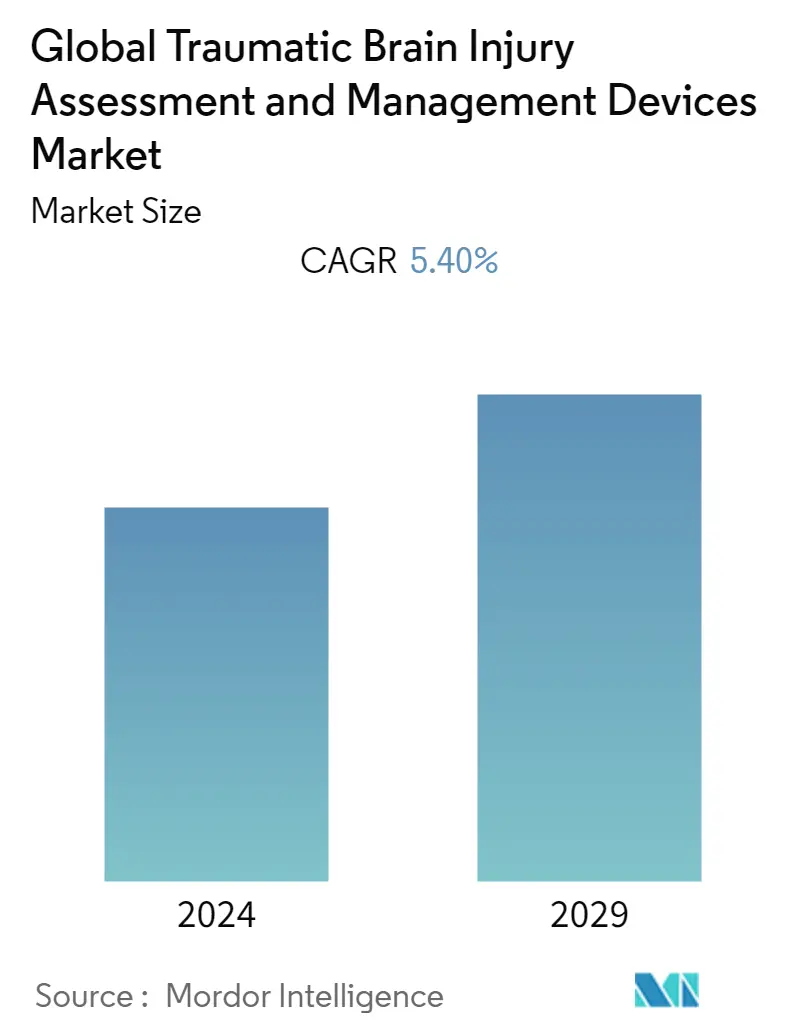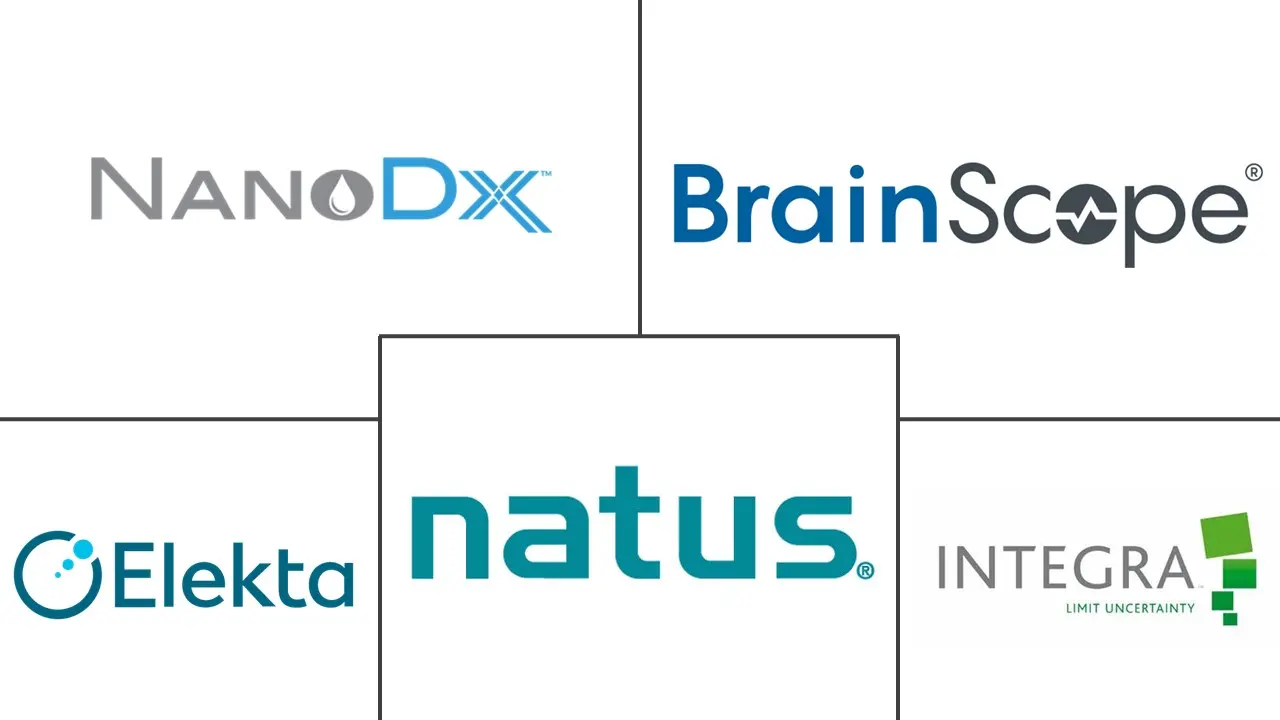Market Size of Global Traumatic Brain Injury Assessment and Management Devices Industry

| Study Period | 2019 - 2029 |
| Base Year For Estimation | 2023 |
| CAGR | 5.40 % |
| Fastest Growing Market | Asia Pacific |
| Largest Market | North America |
| Market Concentration | Medium |
Major Players
*Disclaimer: Major Players sorted in no particular order |
Traumatic Brain Injury Assessment & Management Devices Market Analysis
The traumatic brain injury assessment and management devices market is expected to register a CAGR of 5.4% during the forecast period.
The COVID-19 pandemic has had widespread consequences for healthcare systems around the world. It resulted in extensive changes to the referral patterns, management, and rehabilitation of surgical conditions. For instance, according to an article published in World Neurosurgery in December 2021 on traumatic brain injury (TBI), surgical management was significantly reduced in the United Kingdom, and TBI patients were more likely to be managed locally with neurosurgical assistance outside of the neurosurgical facility during the pandemic.
Restrictions put in place by the government during COVID-19 disrupted the management of TBI patients. Additionally, traumatic brain injury instances have dramatically decreased as a result of COVID-19 limits. For instance, as per the same study mentioned above, road traffic accident (RTA)-related fatalities decreased by 22% in the UK between the pandemic period and the same period the previous year. As a result, the decrease in TBI incidence during the pandemic hampered the growth of the studied market. However, since the lockdown restrictions were lifted, the industry has been recovering well. The demand for surgical operations, treatments, and hospital visits rises as procedures are resumed, which is expected to increase the demand for TBI assessment and management devices over the forecast period.
Certain factors driving the market growth include the increasing incidence of traumatic brain injuries and initiatives by key market players. In April 2022, the BMJ Journals published an article stating that India is responsible for 21% of all new traumatic brain injury cases and nearly a quarter of all traumatic death cases worldwide. Additionally, according to a study published in the Clinical Medicine Journal in March 2021, TBI is a major and developing health issue in the United Kingdom. TBI is responsible for around 900,000 emergency department (ED) visits and over 200,000 hospital admissions in England each year and the rate of severe head imhury is between 10% and 20%. Thus, significant burden of TBI in England is expected to increase the demand for TBI assessment and management devices, which is likely to boost the market growth.
Furthermore, initiatives by key market players such as mergers and acquisitions, product approval as well as launches, are other factors contributing to the market growth. For instance, in February 2021, the US FDA approved the commercialization of a novel gadget designed to be worn around the neck of athletes aged 13 years and above during sporting activities to help protect the brain from the consequences of repetitive sub-concussive head blows. The Q-Collar is a non-invasive C-shaped collar that applies compressive force to the neck and increases blood volume to help reduce brain movement within the cranial space after a head trauma. The gadget may lessen the occurrence of specific brain abnormalities linked with brain injury.
However, the high cost of advanced devices is expected to hinder market growth.
Traumatic Brain Injury Assessment & Management Devices Industry Segmentation
As per the scope of the report, Traumatic Brain Injury (TBI) is a disruption in the normal function of the brain that can be caused by a blow, bump, or jolt to the head, the head suddenly and violently hitting an object or when an object pierces the skull and enters brain tissue. The medical devices that are used to assess and manage the condition are considered traumatic brain injury assessment and management devices.
The Traumatic Brain Injury Assessment and Management Devices Market is Segmented by Device Type (Imaging Devices, Pressure Monitors, Point-of-Care Testing Devices, and Others), End-User (Hospitals, Diagnostic Centers, and Others), and Geography (North America, Europe, Asia-Pacific, Middle East and Africa, and South America). The market report also covers the estimated market sizes and trends for 17 different countries across major regions globally. The report offers the value (in USD million) for the above segments.
| By Device Type | |
| Imaging Devices | |
| Pressure Monitors | |
| Point-of-Care Testing Devices | |
| Other Device Types |
| By End User | |
| Hospitals | |
| Diagnostic Centers | |
| Other End Users |
| Geography | ||||||||
| ||||||||
| ||||||||
| ||||||||
| ||||||||
|
Global Traumatic Brain Injury Assessment and Management Devices Market Size Summary
The traumatic brain injury assessment and management devices market is poised for growth, driven by an increasing incidence of traumatic brain injuries and strategic initiatives by key market players. The market is recovering from the disruptions caused by the COVID-19 pandemic, which had led to a temporary decline in TBI cases and altered management practices. As lockdown restrictions have eased, there has been a resurgence in demand for surgical operations and hospital visits, which is expected to bolster the market. The rising number of brain injuries due to road accidents and sports-related incidents further underscores the need for advanced assessment and management devices. Additionally, the establishment of new healthcare facilities and the expansion of existing ones are anticipated to contribute to market growth.
Key market players are actively engaging in mergers, acquisitions, and product launches to enhance their market presence. Innovations such as the Q-Collar and the i-STAT Alinity platform highlight the industry's focus on developing advanced technologies to mitigate the effects of brain injuries. Despite the high cost of these devices posing a challenge, the market is supported by significant investments and approvals from regulatory bodies like the US FDA. The competitive landscape is characterized by the presence of major companies such as BrainScope, Integra Lifesciences, and Natus Medical Incorporated, which hold substantial market shares. These developments, coupled with ongoing research and technological advancements, are expected to drive the market's expansion over the forecast period.
Global Traumatic Brain Injury Assessment and Management Devices Market Size - Table of Contents
-
1. MARKET DYNAMICS
-
1.1 Market Overview
-
1.2 Market Drivers
-
1.2.1 Increasing Incidence of Traumatic Brain Injuries
-
1.2.2 Technological Advancements
-
-
1.3 Market Restraints
-
1.3.1 High Cost of Devices
-
-
1.4 Porter's Five Forces Analysis
-
1.4.1 Threat of New Entrants
-
1.4.2 Bargaining Power of Buyers/Consumers
-
1.4.3 Bargaining Power of Suppliers
-
1.4.4 Threat of Substitute Products
-
1.4.5 Intensity of Competitive Rivalry
-
-
-
2. MARKET SEGMENTATION (Market Size by Value - USD million)
-
2.1 By Device Type
-
2.1.1 Imaging Devices
-
2.1.2 Pressure Monitors
-
2.1.3 Point-of-Care Testing Devices
-
2.1.4 Other Device Types
-
-
2.2 By End User
-
2.2.1 Hospitals
-
2.2.2 Diagnostic Centers
-
2.2.3 Other End Users
-
-
2.3 Geography
-
2.3.1 North America
-
2.3.1.1 United States
-
2.3.1.2 Canada
-
2.3.1.3 Mexico
-
-
2.3.2 Europe
-
2.3.2.1 Germany
-
2.3.2.2 United Kingdom
-
2.3.2.3 France
-
2.3.2.4 Italy
-
2.3.2.5 Spain
-
2.3.2.6 Rest of Europe
-
-
2.3.3 Asia-Pacific
-
2.3.3.1 China
-
2.3.3.2 Japan
-
2.3.3.3 India
-
2.3.3.4 Australia
-
2.3.3.5 South Korea
-
2.3.3.6 Rest of Asia-Pacific
-
-
2.3.4 Middle East and Africa
-
2.3.4.1 GCC
-
2.3.4.2 South Africa
-
2.3.4.3 Rest of Middle East and Africa
-
-
2.3.5 South America
-
2.3.5.1 Brazil
-
2.3.5.2 Argentina
-
2.3.5.3 Rest of South America
-
-
-
Global Traumatic Brain Injury Assessment and Management Devices Market Size FAQs
What is the current Global Traumatic Brain Injury Assessment and Management Devices Market size?
The Global Traumatic Brain Injury Assessment and Management Devices Market is projected to register a CAGR of 5.40% during the forecast period (2024-2029)
Who are the key players in Global Traumatic Brain Injury Assessment and Management Devices Market?
BrainScope, Integra Lifesciences, NanoDx, Inc., Natus Medical Incorporated and Elekta AB are the major companies operating in the Global Traumatic Brain Injury Assessment and Management Devices Market.
Global Traumatic Brain Injury Assessment and Management Devices Report Snapshots
- Global Traumatic Brain Injury Assessment and Management Devices Market Size
- Global Traumatic Brain Injury Assessment and Management Devices Market Share
- Global Traumatic Brain Injury Assessment and Management Devices Market Trends
- Global Traumatic Brain Injury Assessment and Management Devices Companies

